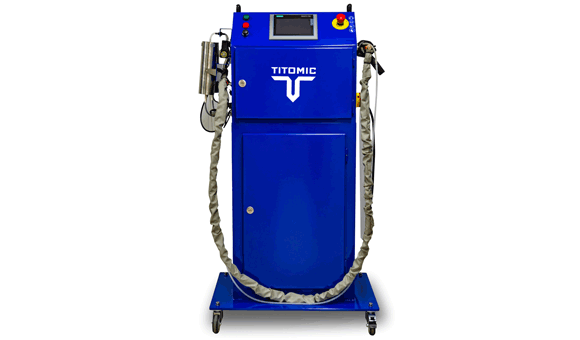Join the Expert Committee for the 2024 3D Printing Industry Awards to help select the winners!
Australian metal 3D printer manufacturer Titomic has announced the sale of its cold spray additive manufacturing (CSAM) systems to the leading Spanish technology center and engineering solutions provider, Fundación Centro Tecnológico Miranda de Ebro (CTME). This sale follows an earlier sale of D523 systems to the Dutch Army for Ukraine’s war effort.
According to Titomic, this transaction indicates a sale price of A$495,000 for the systems to CTME. As per this sale, CTME has acquired both D623 medium-pressure and D523 low-pressure cold spray systems from Titomic, including a powder feeder and an integrated robotic spray booth. The booth features dust suction and an XYZ arm for precise spray head control, enabling effortless switching between systems for versatile cold spray applications.
This collaboration with Titomic is part of CTME’s participation in the SURFERA-PLUS project, which is financed by the Centre for Industrial Technological Development through the Spanish Ministry of Science and Innovation. CTME received a grant for Excellence Technological Centres for this project.
“The integration of Titomic’s advanced cold spray technology into our operations significantly enhances our capabilities. It aligns perfectly with our mission to continually seek out and implement the latest technologies to offer our clients the most innovative solutions,” said, Juan José García Ruiz, Director of CTME.

Cold spray additive manufacturing
Utilizing cold spray technology, Titomic combines kinetic energy, low temperatures, and supersonic speeds to efficiently coat and repair parts. This method of spraying metal particles enables the creation of coatings boasting enhanced adhesion, conductivity, corrosion resistance, density, and thickness.
Titomic’s D523 system utilizes cold spray technology, a metal repair method that propels metal particles at supersonic speeds to create strong layers without heat distortion. This mobile, low-pressure system enables cost-effective, on-site repairs and coatings, eliminating disassembly needs.
The addition of the D623 expands Titomic’s range of products, offering more options for potential customers with differing needs. Distinguished by its ability to deposit tougher metals, surpassing the capabilities of the D523, the D623 elevates the system’s functionality to create wear-resistant coatings and restore high-wear parts.
These systems find applications in various industries, including the repair and restoration of metal parts such as engine components and molds, as well as in sealing, corrosion protection, electrical conductivity enhancement, and AM, among others.
Titomic isn’t the only company incorporating CSAM technology in its portfolio. Back in 2020, a novel CSAM process from Impact Innovations addressed a challenge in processing the titanium alloy Ti-6Al-4V for cold spray. Utilizing nitrogen gas as a propellant, the method achieved significantly reduced porosity levels (below 0.2%) in printed parts, says Impact Innovations.
More uses of the CSAM process include GE reportedly leveraging the technology to repair its GE90 engine gearbox. Additionally, SPEE3D commercialized a cold spray 3D printer, LightSPEE3D, which the Australian Army previously employed for field testing and manufacturing affordable metal 3D printed rocket engines.
Titomic’s 3D printing efforts
Through the incorporation of Titomic’s cold spray systems, CTME enhances its operational capacities by integrating low and medium-pressure cold spray technology. Allowing the application of alloys and metals at lower temperatures, these systems offer opportunities for research and knowledge exchange among its manufacturing clients
The setup effectively combines three systems into one, providing CTME with increased operational flexibility. This design increases flexibility by allowing the institute to switch between low and medium pressure within the same workspace. With increased versatility for application range, workflows are streamlined across diverse cold spray projects.
By many measures, Titomic’s expertise previously made the headlines. In December 2021, Titomic’s acquisition of Dycomet Europe, a competitor in cold spray technology located in the Netherlands, bolstered Titomic’s global presence. With this deal, Titomic gained a foothold in Europe, complementing its existing headquarters in Australia and Titomic USA subsidiary. Moreover, Dycomet Europe brings a robust customer order pipeline across the continent, providing Titomic with an immediate revenue stream.
In another news, aerospace manufacturer Boeing partnered with Titomic to advance additive manufacturing within the space industry. Collaboratively, the companies planned to explore the use of sustainable titanium powders to 3D print components for space systems.
What 3D printing trends do the industry leaders anticipate this year?
What does the Future of 3D printing hold for the next 10 years?
To stay up to date with the latest 3D printing news, don’t forget to subscribe to the 3D Printing Industry newsletter or follow us on Twitter, or like our page on Facebook.
While you’re here, why not subscribe to our Youtube channel? Featuring discussion, debriefs, video shorts, and webinar replays.
Featured image shows Titomic’s D523 Cold Spray 3D printer. Photo via Titomic.


